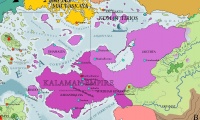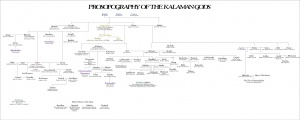Difference between revisions of "Kalama"
Trismegistus (talk | contribs) m (→Kalaman Epics) |
Trismegistus (talk | contribs) m |
||
| Line 1: | Line 1: | ||
| − | Kalama is the [[Ithatian Language|Ithatian]] name given in the early first century before [[Salmakhamer]] to the pre-Midretassene civilization of [[Corundy]]. The civilization according to Kalaman records began shortly after the [[Flood of Aturyanda]] and persisted with many changes and revolutions until the immigration of the | + | Kalama is the [[Ithatian Language|Ithatian]] name given in the early first century before [[Salmakhamer]] to the pre-Midretassene civilization of [[Corundy]]. The civilization according to Kalaman records began shortly after the [[Flood of Aturyanda]] and persisted with many changes and revolutions until the immigration of the Midrinksi Tribes, 1100 [[Ante Salmakhamer|AS]] to 475 [[AS]] at the end of which Kalama had ceased to exist as a distinct and sovereign civilization. Kalaman cultural heritage dominates the [[Great Valley of Lord Vimal]] in [[Corundy]] and the [[Kalaman Language]] is the parent language of [[Kushiri Language|Kushiri]] and [[Jaithan Language|Jaithan]]. The name Kalama itself is not actually used by the Kushiri and Jaithan people who are the modern-day inheritors of this long and highly cultural civilization. Scholars prefer the term [[Jathya-Dhumi]]. However, the terms Kalama and Kalaman prevail outside of these languages. |
[[File:KalamanEmpireca2500AS.jpg|thumb|200px|Extent of Kalaman Empire during the [[Surizhah Kingdom]] around 2500 [[AS]]]] | [[File:KalamanEmpireca2500AS.jpg|thumb|200px|Extent of Kalaman Empire during the [[Surizhah Kingdom]] around 2500 [[AS]]]] | ||
| Line 5: | Line 5: | ||
=History= | =History= | ||
{{See also|Chronology of Kalama|List of Rulers and Dynasties of Kalama}} | {{See also|Chronology of Kalama|List of Rulers and Dynasties of Kalama}} | ||
| − | Kalaman History is immense, reaching back to the [[Flood of Aturyanda]]. The millennia before the time of chaos which include periods before about 6100 AS is regarded by most scholars as semi-legendary. Scholars consider most written history of Kalama from 6100 AS which is the beginning of the city-state period towards the present to contain many credible facts, including dynasties, rulers, and cultural history. The dynasties from this time on are grouped into six successive kingdoms: the [[Gahashpujani Kingdom]], the [[Pandhauzhi Kingdom]], the [[Neibhu-Yona Kingdom]], the [[Surizhah Kingdom]], the [[Tamukh Kingdom]], and the [[Jatha-Nebir Kingdom]]. After the Jatha-Nebir Kingdom, there is the transitional period of the | + | Kalaman History is immense, reaching back to the [[Flood of Aturyanda]]. The millennia before the time of chaos which include periods before about 6100 AS is regarded by most scholars as semi-legendary. Scholars consider most written history of Kalama from 6100 AS which is the beginning of the city-state period towards the present to contain many credible facts, including dynasties, rulers, and cultural history. The dynasties from this time on are grouped into six successive kingdoms: the [[Gahashpujani Kingdom]], the [[Pandhauzhi Kingdom]], the [[Neibhu-Yona Kingdom]], the [[Surizhah Kingdom]], the [[Tamukh Kingdom]], and the [[Jatha-Nebir Kingdom]]. After the Jatha-Nebir Kingdom, there is the transitional period of the Midrinksi Settlement of Kalama and the end of classical Kalaman civilization. |
[[File:CorundianHills.jpg|thumb|400px|Hills of Ancient Kalama]] | [[File:CorundianHills.jpg|thumb|400px|Hills of Ancient Kalama]] | ||
Revision as of 21:06, 3 June 2019
Kalama is the Ithatian name given in the early first century before Salmakhamer to the pre-Midretassene civilization of Corundy. The civilization according to Kalaman records began shortly after the Flood of Aturyanda and persisted with many changes and revolutions until the immigration of the Midrinksi Tribes, 1100 AS to 475 AS at the end of which Kalama had ceased to exist as a distinct and sovereign civilization. Kalaman cultural heritage dominates the Great Valley of Lord Vimal in Corundy and the Kalaman Language is the parent language of Kushiri and Jaithan. The name Kalama itself is not actually used by the Kushiri and Jaithan people who are the modern-day inheritors of this long and highly cultural civilization. Scholars prefer the term Jathya-Dhumi. However, the terms Kalama and Kalaman prevail outside of these languages.
History
Kalaman History is immense, reaching back to the Flood of Aturyanda. The millennia before the time of chaos which include periods before about 6100 AS is regarded by most scholars as semi-legendary. Scholars consider most written history of Kalama from 6100 AS which is the beginning of the city-state period towards the present to contain many credible facts, including dynasties, rulers, and cultural history. The dynasties from this time on are grouped into six successive kingdoms: the Gahashpujani Kingdom, the Pandhauzhi Kingdom, the Neibhu-Yona Kingdom, the Surizhah Kingdom, the Tamukh Kingdom, and the Jatha-Nebir Kingdom. After the Jatha-Nebir Kingdom, there is the transitional period of the Midrinksi Settlement of Kalama and the end of classical Kalaman civilization.
Divinities
Jathya-Dhumi Triad
Dramegginite Pantheon
The divinities of ancient Kalama are sometimes called the Drameginnite Pantheon as they or their predecessors were worshiped in antediluvian Drameggin, a civilization attested to lands now submerged in the Memnosian Sea.
- Vahmu: Goddess of Infinite Creation, former patron goddess of city of Kathyasundi, creator of Mahada.
- Thulya: Sun Goddess and solar gods
- Atur: God of Rain, Snow, and Ice (Compare Thwar)
- Hesukh {Hesog, Hesug, Sug}: God of Hidden Waters, father of sea gods and earthquakes
- Taswa: God of Night-time Dreams
- Mahada (Maghadha): Mother Earth goddess, mother of Bambashra, Zhaddhin, and Onekhyá. She has no husband, but conceives by Atur, Hesukh, and others.
- Onekhyá: God of War, older brother to Zhaddhin
- Zhaddhin: Charismatic, lazy god son who lives with Mahada, earth mother goddess. He is father of Zakshim, also father of illegitimate son, Razug, who is god of thieves
- Sirthi: Goddess of gold, daughter of Thulya and wife to Zhaddhin
- Zakshim: Merchant God Father
- Bambashra: Son of Mahada, God of Sailing and sea ships
- Razug: God of Thieves, illegitimate son of Zhaddhin
- Shihir: daughter, goddess of fishermen
- Kaina: goddess of Starmoon
- Hukshal: goddess of winds
- Khir: God of sunmoon
- Blue Bull of Kalama, mount of Zakshim
- Silver Elephant of Kalama, mount of Atur
Kalaman Geography
Place-Names
- -aphuna: lake
- -hirathu: river
- -oksha: city, city of
- -ttha: sea
Kalaman Geographic Proper Names
- Bakyahumya: Thyria
- Bhimalaphuna: Lake Vimal
- Baughurah: Adamantine Mountains
- Dhamalya: Deliops
- Dhamat, Dhamat-hirathu: Thybdis, Thybdis River
- Goshamya, Goshamihirathu: Shadew, Shadevan River
- Jakubya: Throvy
- Jalukhrá: Shelekhumbia
- Kaspatya: Ebinóë, Ebinóëse Highlands
- Kimbugottha: Jaggudorns
- Kshandiguha: Corundy
- Maulaskaya: Shadevan Delta
- Pamubharttha: Memnosian Sea
- Prakruthyattha: Pallathantic Sea
- Saumakya: Thykomos
- Sayatha: Pytharnia
- Tawaddha: Desthor
Six Castes of Ancient Kalama
- Priest Caste (includes kings and magi)
- Landowner Caste (Aristocrats)
- Warrior Caste
- Scribal Caste (includes wizards)
- Crafters Caste
- Farmer Caste
Kalaman Epics
- Ashwakikumi, account of the gods
- Dithanakumi, account of the titan god, Dithan
- Zakshimukumi, account of the merchant god, Zakshim
- Aturyandakumi, account of the first ruler of Kalama, Aturyanda, including the Great Flood
- Jairutthalakumi, account of Jairutthala, establisher of the Jairutthalese Dynasty
- Satranakumi, account of the demi-god, Satran
- War of the Dragonfolk
Cultural Legacy of Kalama
- Astronomy
- Architecture
- Civil Engineering
- Engineering
- Hirgunya Script
- Historical Records
- Kalaman Literature
- Music
- Religion
Sources
 Primary Sources
Primary Sources
- Aturyandakumi, Garshaha Rubhira, attributed to early 8th millennium before Salmakhamer
- Jairutthalakumi, Samptarah ahwa Kamaddhu, ca 4700 AS
- Shayarin Zhampha, ca 3500 AS
 Secondary Sources
Secondary Sources
- Gods of Kalama, Orkybanthinantis of Addinoro, ca 600
- Index of Modern Kalamantology, 2679 to present
- Kalamantica, Orkybanthinantis of Addinoro, ~600
- Of Ancient Kalaman Gods and the Titans, Gekkas Phrudaks, 1633
See Also
- Aturyanda
- Corundy
- Dramegginite Gods and Religion
- Flood of Aturyanda
- Jairutthalese Empire
- Kalaman Language
- Kalamantica
- Kalamantizing Philosophers
- Languages of Corundy
- List of Rulers and Dynasties of Kalama
- Zhampha
| This article is a stub. It requires further development by the creator. |


